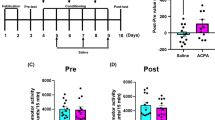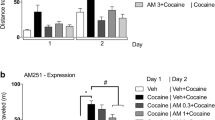Abstract
Rationale
Acute behavioural effects and motivational responses induced by nicotine can be modulated by the endocannabinoid system supporting the existence of a physiological interaction between these two systems.
Objectives
The present study was designed to examine the possible involvement of the cannabinoid system in the anxiolytic- and anxiogenic-like responses induced by nicotine in mice.
Methods
Animals were only exposed once to nicotine. The acute administration of low (0.05) or high (0.8 mg/kg, s.c.) doses of nicotine produced opposite effects in the elevated plus-maze, i.e. anxiolytic- and anxiogenic-like responses, respectively. The effects of the pretreatment with the CB1 cannabinoid receptor antagonist, rimonabant (0.25, 0.5 and 1 mg/kg, i.p.), and the cannabinoid agonist, Δ9-tetrahydrocannabinol (Δ9-THC, 0.1 mg/kg, ip), were evaluated on the anxiolytic- and anxiogenic-like responses induced by nicotine.
Results
Rimonabant completely abolished nicotine-induced anxiolytic-like effects and increased the anxiogenic-like responses of nicotine, suggesting an involvement of CB1 receptors in these behavioural responses. On the other hand, Δ9-THC failed to modify nicotine anxiolytic-like responses but attenuated its anxiogenic-like effects. In addition, the association of non-effective doses of Δ9-THC and nicotine produced clear anxiolytic-like responses.
Conclusions
These results demonstrate that the endogenous cannabinoid system is involved in the regulation of nicotine anxiety-like behaviour in mice and provide new findings to support the use of cannabinoid antagonists in the treatment of tobacco addiction.





Similar content being viewed by others
References
Acquas E, Pisanu A, Marrocu P, Di Chiara G (2000) Cannabinoid CB(1) receptor agonists increase rat cortical and hippocampal acetylcholine release in vivo. Eur J Pharmacol 401:179–185
Anthenelli RM, Despres JP (2004) Effects of rimonabant in the reduction of major cardiovascular risk factors. Results from the STRATUS-US trial (smoking cessation in smokers motivated to quit). In: American College of Cardiology 53rd annual scientific session, New Orleans, LA, 7–10 Mar 2004
Balerio GN, Aso E, Berrendero F, Murtra P, Maldonado R (2004) Delta9-tetrahydrocannabinol decreases somatic and motivational manifestations of nicotine withdrawal in mice. Eur J Neurosci 20:2737–2748
Balerio GN, Aso E, Maldonado R (2005) Involvement of the opioid system in the effects induced by nicotine on anxiety-like behaviour in mice. Psychopharmacology 181:260–269
Brazell MP, Mitchell SN, Gray JA (1991) Effect of acute administration of nicotine on in vivo release of noradrenaline in the hippocampus of freely moving rats: a dose–response and antagonist study. Neuropharmacology 30:823–833
Bremner JD, Krystal JH, Southwick SM, Charney DS (1996) Noradrenergic mechanisms in stress and anxiety: I. Preclinical studies. Synapse 23:28–38
Brioni JD, O’Neill AB, Kim DJ, Decker MW (1993) Nicotinic receptor agonists exhibit anxiolytic-like effects on the elevated plus-maze test. Eur J Pharmacol 238:1–8
Brioni JD, O’Neill AB, Kim DJ, Buckley MJ, Decker MW, Arneric SP (1994) Anxiolytic-like effects of the novel cholinergic channel activator ABT-418. J Pharmacol Exp Ther 271:353–361
Castañé A, Valjent E, Ledent C, Parmentier M, Maldonado R, Valverde O (2002) Lack of CB1 cannabinoid receptors modifies nicotine behavioural responses, but not nicotine abstinence. Neuropharmacology 43:857–867
Cheeta S, Irvine E, File SE (2001) Social isolation modifies nicotine’s effects in animal tests of anxiety. Br J Pharmacol 132:1389–1395
Clarke PB, Kumar R (1983) The effects of nicotine on locomotor activity in non-tolerant and tolerant rats. Br J Pharmacol 78:329–337
Cohen C, Perrault G, Voltz C, Steinberg R, Soubrie P (2002) SR141716, a central cannabinoid (CB1) receptor antagonist, blocks the motivational and dopamine-releasing effects of nicotine in rats. Behav Pharmacol 13:451–463
Cohen C, Perrault G, Griebel G, Soubrie P (2005) Nicotine-associated cues maintain nicotine-seeking behavior in rats several weeks after nicotine withdrawal: reversal by the cannabinoid (CB1) receptor antagonist, rimonabant (SR141716). Neuropsychopharmacology 30:145–155
Compton DR, Aceto MD, Lowe J, Martin BR (1996) In vivo characterization of a specific cannabinoid receptor antagonist (SR141716A): inhibition of delta 9-tetrahydrocannabinol-induced responses and apparent agonist activity. J Pharmacol Exp Ther 277:586–594
Costall B, Kelly ME, Naylor RJ, Onaivi ES (1989) The actions of nicotine and cocaine in a mouse model of anxiety. Pharmacol Biochem Behav 33:197–203
Dani JA (2001) Overview of nicotinic receptors and their roles in the central nervous system. Biol Psychiatry 49:166–174
Dewey WL (1986) Cannabinoid pharmacology. Pharmacol Rev 38:151–178
File SE (1992) Behavioural detection of anxiolytic action. In: Elliot JM, Heal DJ, Marsden CA (eds) Experimental approaches to anxiety and depression. Wiley, London, pp 25–44
Fu Y, Matta SG, James TJ, Sharp BM (1998) Nicotine-induced norepinephrine release in the rat amygdala and hippocampus is mediated through brainstem nicotinic cholinergic receptors. J Pharmacol Exp Ther 284:1188–1196
Gilbert DG, Robinson JH, Chamberlin CL, Spielberger CD (1989) Effects of smoking/nicotine on anxiety, heart rate, and lateralization of EEG during a stressful movie. Psychophysiology 26:311–320
González S, Cascio MG, Fernández-Ruiz J, Fezza F, Di Marzo V, Ramos JA (2002) Changes in endocannabinoid contents in the brain of rats chronically exposed to nicotine, ethanol or cocaine. Brain Res 954:73–81
Gray JA, Mitchell SN, Joseph MH, Grogoryan G, Daws S, Hodges H (1994) Neurochemical mechanisms mediating the behavioural and cognitive effects of nicotine. Drug Dev Res 31:3–17
Guimaraes S, Carobrez PP, De Aguiar JC, Graeff FG (1991) Anxiolytic effect in the elevated plus-maze of the NMDA receptor antagonist AP7 microinjected into the dorsal periaqueductal grey. Psychopharmacology 103:91–94
Herman JP, Cullinan WE (1997) Neurocircuitry of stress: central control of the hypothalamo–pituitary–adrenocortical axis. Trends Neurosci 20:78–84
Hernández-Tristán R, Arevalo C, Canals S, Leret ML (2000) The effects of acute treatment with delta9-THC on exploratory behaviour and memory in the rat. J Physiol Biochem 56:17–24
Hildebrand BE, Panagis G, Svensson TH, Nomikos GG (1999) Behavioral and biochemical manifestations of mecamylamine-precipitated nicotine withdrawal in the rat: role of nicotinic receptors in the ventral tegmental area. Neuropsychopharmacology 21:560–574
Jessa M, Nazar M, Plaznik A (1995) Anxiolytic-like action of intra-hippocampally administered NMDA antagonists in rats. Pol J Pharmacol 47:81–84
Ledent C, Valverde O, Cossu G, Petitet F, Aubert JF, Beslot F, Bohme GA, Imperato A, Pedrazzini T, Roques BP, Vassart G, Fratta W, Parmentier M (1999) Unresponsiveness to cannabinoids and reduced addictive effects of opiates in CB1 receptor knockout mice. Science 283:401–404
Lichtman AH, Martin BR (1997) The selective cannabinoid antagonist SR 141716A blocks cannabinoid-induced antinociception in rats. Pharmacol Biochem Behav 57:7–12
Martín M, Ledent C, Parmentier M, Maldonado R, Valverde O (2002) Involvement of CB1 cannabinoid receptors in emotional behaviour. Psychopharmacology 159:379–387
Marubio LM, del Mar Arroyo-Jiménez M, Cordero-Erausquin M, Lena C, Le Novere N, de Kerchove d’Exaerde A, Huchet M, Damaj MI, Changeux JP (1999) Reduced antinociception in mice lacking neuronal nicotinic receptor subunits. Nature 398:805–810
Navarro M, Hernández E, Muñoz RM, del Arco I, Villanúa MA, Carrera MR, Rodríguez de Fonseca F (1997) Acute administration of the CB1 cannabinoid receptor antagonist SR 141716A induces anxiety-like responses in the rat. Neuroreport 8:491–496
Okuda H, Shioda S, Nakai Y, Nakayama H, Okamoto M, Nakashima T (1993) The presence of corticotropin-releasing factor-like immunoreactive synaptic vesicles in axon terminals with nicotinic acetylcholine receptor-like immunoreactivity in the median eminence of the rat. Neurosci Lett 161:183–186
Olausson P, Akesson P, Engel JA, Soderpalm B (2001) Effects of 5-HT1A and 5-HT2 receptor agonists on the behavioral and neurochemical consequences of repeated nicotine treatment. Eur J Pharmacol 420:45–54
Onaka T, Palmer JR, Yagi K (1996) Norepinephrine depletion impairs neuroendocrine responses to fear but not novel environmental stimuli in the rat. Brain Res 713:261–268
Ouagazzal AM, Kenny PJ, File SE (1999) Modulation of behaviour on trials 1 and 2 in the elevated plus-maze test of anxiety after systemic and hippocampal administration of nicotine. Psychopharmacology 144:54–60
Pellow S, Chopin P, File SE, Briley M (1985) Validation of open:closed arm entries in an elevated plus-maze as a measure of anxiety in the rat. J Neurosci Methods 14:149–167
Picciotto MR, Zoli M, Lena C, Bessis A, Lallemand Y, Le Novere N, Vincent P, Pich EM, Brulet P, Changeux JP (1995) Abnormal avoidance learning in mice lacking functional high-affinity nicotine receptor in the brain. Nature 374:65–67
Picciotto MR, Caldarone BJ, King SL, Zachariou V (2000) Nicotinic receptors in the brain. Links between molecular biology and behavior. Neuropsychopharmacology 22:451–465
Pomerleau OF (1986) Nicotine as a psychoactive drug: anxiety and pain reduction. Psychopharmacol Bull 22:865–869
Pryor GT, Larsen FF, Husain S, Braude MC (1978) Interactions of delta 9-tetrahydrocannabinol with d-amphetamine, cocaine, and nicotine in rats. Pharmacol Biochem Behav 8:295–318
Rinaldi-Carmona M, Barth F, Heaulme M, Shire D, Calandra B, Congy C, Martínez S, Maruani J, Neliat G, Caput D et al (1994) SR141716A, a potent and selective antagonist of the brain cannabinoid receptor. FEBS Lett 350:240–244
Risinger FO, Oakes RA (1995) Nicotine-induced conditioned place preference and conditioned place aversion in mice. Pharmacol Biochem Behav 51:457–461
Rodríguez de Fonseca F, Rubio P, Menzaghi F, Merlo-Pich E, Rivier J, Koob GF, Navarro M (1996) Corticotropin-releasing factor (CRF) antagonist [d-Phe12,Nle21,38,C alpha MeLeu37]CRF attenuates the acute actions of the highly potent cannabinoid receptor agonist HU-210 on defensive-withdrawal behavior in rats. J Pharmacol Exp Ther 276:56–64
Seth P, Cheeta S, Tucci S, File SE (2002) Nicotinic–serotonergic interactions in brain and behaviour. Pharmacol Biochem Behav 71:795–805
Sharp BM, Matta SG (1993) Detection by in vivo microdialysis of nicotine-induced norepinephrine secretion from the hypothalamic paraventricular nucleus of freely moving rats: dose-dependency and desensitization. Endocrinology 133:11–19
Toth E, Sershen H, Hashim A, Vizi ES, Lajtha A (1992) Effect of nicotine on extracellular levels of neurotransmitters assessed by microdialysis in various brain regions: role of glutamic acid. Neurochem Res 17:265–271
Tripathi HL, Vocci FJ, Brase DA, Dewey WL (1987) Effects of cannabinoids on levels of acetylcholine and choline and on turnover rate of acetylcholine in various regions of the mouse brain. Alcohol Drug Res 7:525–532
Tsou K, Brown S, Sañudo-Peña MC, Mackie K, Walker JM (1998) Immunohistochemical distribution of cannabinoid CB1 receptors in the rat central nervous system. Neuroscience 83:393–411
Valjent E, Mitchell JM, Besson MJ, Caboche J, Maldonado R (2002) Behavioural and biochemical evidence for interactions between Delta 9-tetrahydrocannabinol and nicotine. Br J Pharmacol 135:564–578
Zimmer A, Zimmer AM, Hohmann AG, Herkenham M, Bonner TI (1999) Increased mortality, hypoactivity, and hypoalgesia in cannabinoid CB1 receptor knockout mice. Proc Natl Acad Sci U S A 96:5780–5785
Acknowledgements
This work has been supported by grants from National Institutes of Health (1R01-DA016768-0111), Ministerio de Educación y Ciencia (BFU 2004-00920/BFI), Marató TV3, Redes de Centros y Grupos del Instituto de Salud Carlos III (C03/06 and G03/005), Generalitat de Catalunya (2002 SGR00193) and the European Comission (Quality of Life and Management of Living Resources QLRT-2001-01691 LSHM-CT 2004-005166). Graciela Balerio is a postdoctoral fellow supported by “Fundación Carolina”. We thank the helpful assistance of Ms. Andreea Bura.
Author information
Authors and Affiliations
Corresponding author
Rights and permissions
About this article
Cite this article
Balerio, G.N., Aso, E. & Maldonado, R. Role of the cannabinoid system in the effects induced by nicotine on anxiety-like behaviour in mice. Psychopharmacology 184, 504–513 (2006). https://doi.org/10.1007/s00213-005-0251-9
Received:
Accepted:
Published:
Issue Date:
DOI: https://doi.org/10.1007/s00213-005-0251-9




